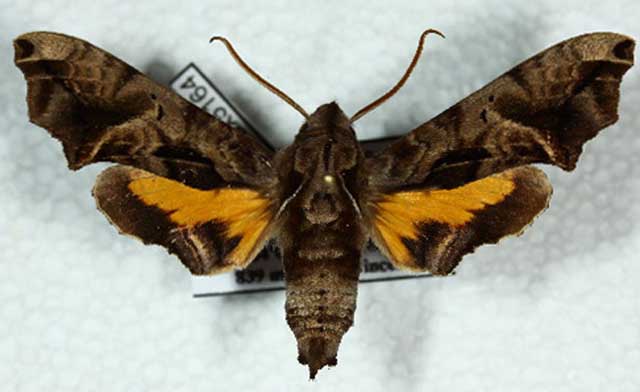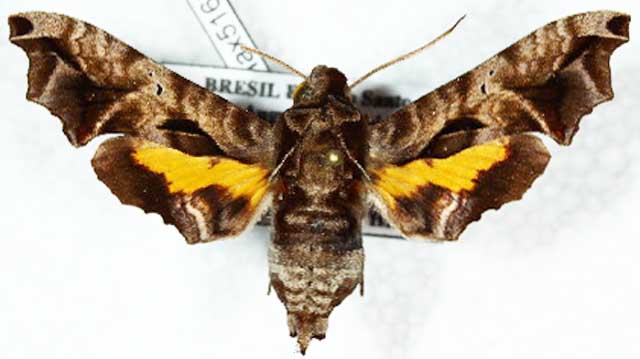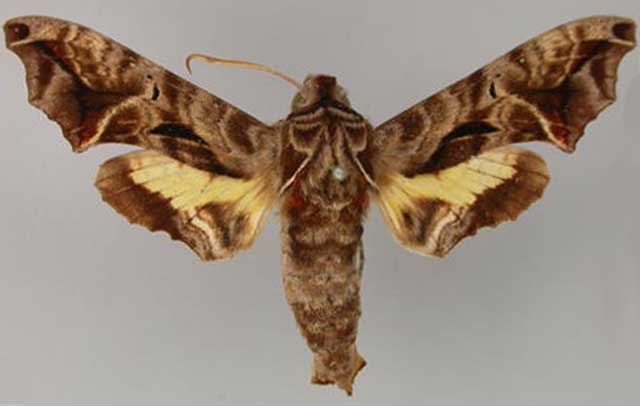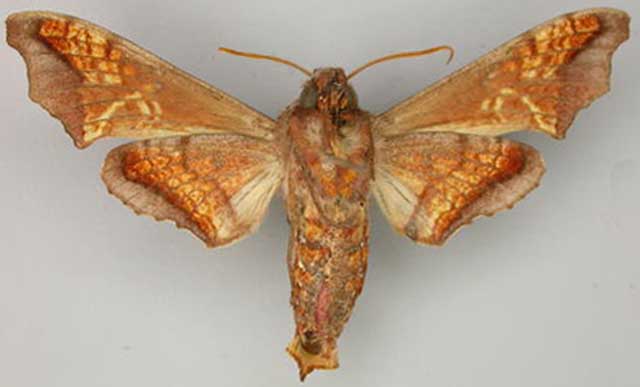|
|
Created as per Ian Kitching: My Species, April 16, 2022
Updated as per Jean Haxaire images on BOLD, April 16, 2022
Updated as per European Entomologist, October 21, 2019, Vol 11 3 + 4, Jean Haxaire and Carlos C. B. Mielke, April 16, 2022
|
Nyceryx lemonia
[Gehlen, 1941]

Nyceryx lemonia male, courtesy of Jean Haxaire.
This site has been created by Bill Oehlke.
Comments, suggestions and/or additional information are welcomed by Bill.
TAXONOMY:
Family: Sphingidae, Latreille, 1802
Subfamily: Macroglossinae, Harris, 1839
Tribe: Dilophonotini, Burmeister, 1878
Genus: Nyceryx Boisduval, [1875] ...........
Species: lemonia [Gehlen, 1941]
|
DISTRIBUTION:
Nyceryx lemonia (wingspan: mm; females larger than males) flies in
eastern Brazil: Bahia to Parana,
Argentina: Misiones, and
Bolivia: Santa Cruz.
Ian Kitching writes: This species has been "Synonymized with Nyceryx continua by Kernbach, 1965, Mitt. dt. ent. Ges. 24: 89.
Reinstated as a species by Kitching and Rougerie et al., 2018, Biodivers. Data J. 6: e22236;
then again later by Haxaire & Mielke, [2020], European Ent. 11 (3+4): 146."
At one time (Haxaire & Herbin, 2000) treated this moth as a synonym of N. alophus, but in 2019-2020 Haxaire & Mielke give it full species status and write,
"The type locality of N. lemonia is unclear (Gehlen 1941), but the first author
examined the holotype in ZSM and it is evident that it is a distinct species rather than
a synonym of Nyceryx continua
(Walker, 1856). Habitus, genitalia, and barcode give
evidences for our decision. If the determination can be grasped from the habitus, the
dissection is essential to confirm it.
"Nyceryx lemonia seems to show a more contrasted ornamentation, with a small reddish-brown patch at the anal angle of the dorsal
forewing. That little patch is present in all examined specimens of N. lemonia and is always absent on N. alophus. The black discal spot is simple on
N. lemonia, double on N. alophus.

Nyceryx lemonia male, courtesy of Jean Haxaire.
I brightened the image above to see if I could find the small reddish brown patch, mentioned above. It is very small, only about the size of the cell spot, but it
is there.
"On the dorsal hindwing, the anal patch shows a succession of four thin
white lines, while two in N. alophus, making that area more striped in the former."

Nyceryx lemonia male, courtesy of Ian Kitching, MY Species, CC.
The small red-brown spot seems to rest upon the lowest curve of the white band that runs from the forewing cell to the anal angle, and is easiest to see on the
wing to the viewer's right, very close to the tip of the anal angle.

Nyceryx lemonia male (verso), courtesy of Ian Kitching, MY Species, CC.
FLIGHT TIMES:
Moths are probably on the wing in just about every month.
ECLOSION:
Adults eclose, usually within two to four weeks from pupation date.
SCENTING AND MATING:
Females call in the males with a pheromone released from a gland at the tip of the abdomen.
Females are active just after midnight with males beginning night flight around 1:00 am.
EGGS, LARVAE, PUPAE:
Larvae possibly feed on Xylophragma seemannianum.
Wolfgang Walz reports Nycerys larvae on Pingo-de-ouro (Duranta repens aurea), família Bignoniaceae, in Minas Gerais, Brazil.
Return to Sphingidae Index
Return to Dilophonotini Tribe
Goto South American Index



